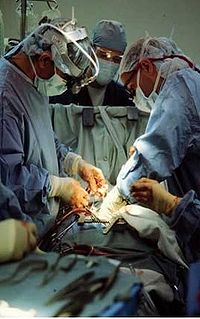
Photo from wikipedia
PURPOSE Low- and middle-income countries (LMICs) have only 19% of the global surgical workforce yet see 80% of worldwide deaths from noncommunicable diseases. We aimed to interrogate the correlation between… Click to show full abstract
PURPOSE Low- and middle-income countries (LMICs) have only 19% of the global surgical workforce yet see 80% of worldwide deaths from noncommunicable diseases. We aimed to interrogate the correlation between pediatric surgical workforce density (PSWD) and survival from pediatric surgical conditions worldwide. METHODS A systematic review of online databases identified outcome studies for key pediatric surgical conditions (gastroschisis, esophageal atresia, intestinal atresia, and typhoid perforation) as well as PSWD data across low-income (LICs), middle-income (MICs), and high-income countries (HICs). PSWD was expressed as the number of PSs/million children under 15 years of age and we correlated this to surgical outcomes for our case series. RESULTS PSWD ranged between zero (Burundi, The Gambia, and Mauritania) and 125.2 (Poland) across 86 countries. Outcomes for at least one condition were obtained in 61 countries: 50 outcomes in HICs, 52 in MICs and 8 in LICs. The mean survival in our case series was 42.3%, 69.4% and 91.6% for LICs, MICs, and HICs, respectively. A PSWD ≥4 PSs/million children under 15 years of age significantly correlated to odds of survival ≥80% (OR 16.8, p < 0.0001, 95% CI 5.66-49.88). Specifically in the studied LICs and MICs, increasing the PSWD to 4 would require training 1427 additional surgeons. CONCLUSION Using a novel approach, we have established a benchmark for the scale-up of pediatric surgical workforce, which may support broader efforts to reduce childhood deaths from congenital disease. LEVELS OF EVIDENCE 2c - Outcomes Research.
Journal Title: Journal of pediatric surgery
Year Published: 2019
Link to full text (if available)
Share on Social Media: Sign Up to like & get
recommendations!